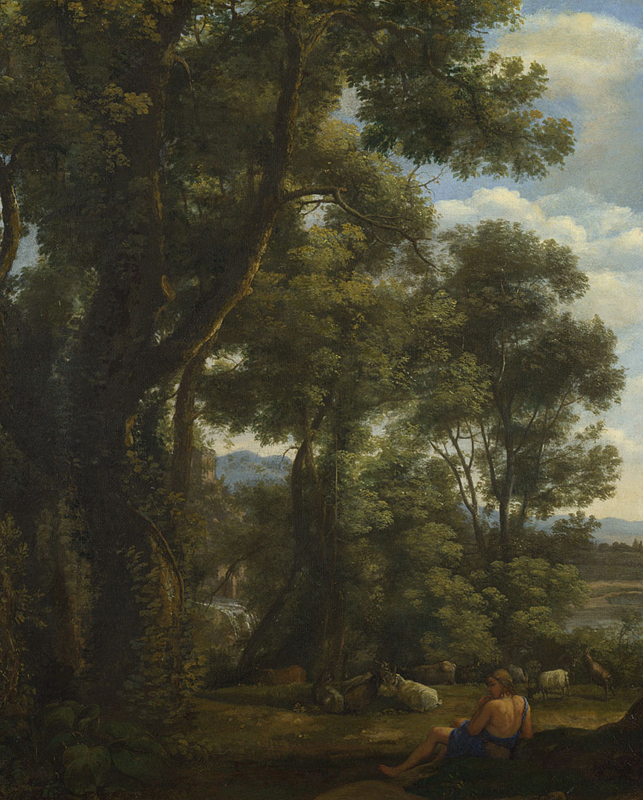A number of the artists featured in the special exhibition Nature and the American Vision: The Hudson River School can also be found in the galleries of the Milwaukee Art Museum. This is the fourth and final in a series of blog posts that will highlight Milwaukee’s artworks during the run of the exhibition.

Although they depicted the American landscape, Hudson River School painters found inspiration in Europe.
Traveling to France or Italy to study Old Masters was a common tradition, even for American artists looking to assert their cultural identity, and they adapted European conventions to a uniquely American vision.
For this blog post, we will use the painting In the Catskills by Asher Brown Durand (American, 1796-1886) as a case study, showing the influence of European artistic traditions.
Background
Before becoming a landscape painter, Durand started his artistic career as an engraver. His first major commission was in 1820; his patron, John Trumbull (American, 1756-1843), hired Durand to make an engraving of his painting The Declaration of Independence.
Durand soon became known for his engraving talents, and he produced everything from bank notes to portraits to copies of other artists’ works. Partly inspired by Thomas Cole (American, born England, 1801-1848) during the 1830s, Durand became increasingly interested in landscape painting. In 1837, the two went on a sketching trip to the Schroon Lake region of the Adirondacks, and this signified Durand’s artistic transition from engraver to landscape painter.

In the summer of 1840 Durand went to Europe, where he studied the works of Old Masters and English artists of earlier generations, and the influence of this trip is evident throughout the rest of his career.
When questioning which European artist influenced Durand the most, historians seem to be divided between two candidates: Claude Lorrain (French, 1600-1682) (usually just called “Claude”) and John Constable (English, 1776-1836). But, Durand’s influences are not in such black and white terms. Instead of choosing one artist, it would be more interesting to compare In the Catskills to works by both artists.
Durand and Claude

To start, let’s compare Durand’s In the Catskills to Claude’s Landscape with Goatherd and Goats (right). Unlike Claude, Durand does not include figures in his landscape but does allude to European artistic traditions in other ways. The composition is the most similar aspect of both paintings. In Goatherds, Claude is creating a circular composition. The large tree to the left frames the painting. The dark shadows contrast with the curving highlight of the tree, leading the viewer’s eye towards the center of the canvas. Durand mirrored this compositional technique. The left edge of Catskills is framed by a tree curving that, along with the receding river, guides the viewer’s eye to the center of the painting.
Both Claude and Durand also use similar lighting, casting an even glow over the canvas, rendering the deepest shadows at left. The middle ground is lighter, and the backgrounds the brightest, with light-blue mountains fading into the distance. It seems to be late afternoon in both works. While the shadows are deep, there is no dramatic contrast between highlights and shadows.
Durand and Constable

Now I want to take the time to compare In the Catskills with a work by John Constable, titled Stratford Mill (left). Like Claude, Constable employs a softer light source, one that creates more shadows but has less dramatic contrast than later works by American Landscape painters. Constable’s influence on Durand is best seen in the focus on empirical details. The artist made multiple cloud studies in order to capture them accurately. Look at the perfect rendering of the bark on the trees and the detailed fishermen. In the far back of the image, the viewer can even see a perfectly executed fence. Each post has a highlight and shadow.
Durand mirrored Constable’s ideas. He was focused on painting directly from nature, sketching in oil to get paintings as lifelike as possible. Like Constable, Durand minutely depicted leaves on trees, bark, branches and twigs. Far off into the distance, viewers can see perfectly rendered trees, just like Constable’s detailed fence.
The strength in Durand’s work is not in his ability to copy other artists (although he was capable of that), but to fuse their style with his own. Near the end of his career, Durand relied too heavily on the Dutch landscape traditions, and lost some of his American appeal. In the Catskills is an amazing piece from the height of his career showing how Durand blended the teachings of Claude and Constable while also appealing to the American tastes.
–Kelsey Rozema, Curatorial Intern

3 replies on “From the Collection: In the Catskills by Asher Brown Durand”
Reblogged this on Nothing Gilded, Nothing Gained–Where Past Meets Present at Middlemay Farm.
[…] next encountered paintings by Thomas Cole (American, 1801–1848) and Asher B. Durand (American, 1796–1886). Instead of focusing on the technical aspects of their pieces, Inness was […]
An absolutely wonderful collection from an outstanding artist. Thanks for your post